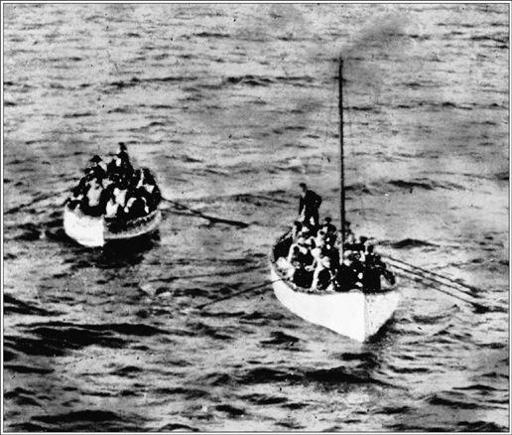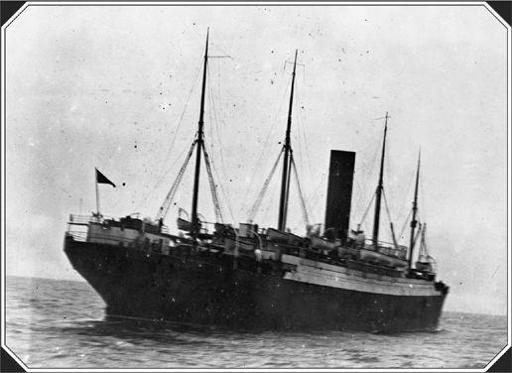Gilded Lives, Fatal Voyage: The Titanic's First-Class Passengers and Their World (37 page)
Read Gilded Lives, Fatal Voyage: The Titanic's First-Class Passengers and Their World Online
Authors: Hugh Brewster
Tags: #Ocean Travel, #Shipwreck Victims, #Cruises, #20th Century, #Upper Class - United States, #United States, #Shipwrecks - North Atlantic Ocean, #Rich & Famous, #Biography & Autobiography, #Travel, #Titanic (Steamship), #History

As Lucy drifted off to sleep, the sixteen remaining boats continued to make their way toward the
Carpathia
. Henry Harper in Boat 3 was struck by how tiny the Cunarder looked compared to the
Titanic
but thought that he had never seen a finer sight. Daisy Spedden, meanwhile, was growing increasingly annoyed with a “fat” woman in Boat 3, who, as she later wrote, “
had been dreadful all along for she never stopped talking and telling the sailors what to do, and she imbibed from her brandy flask frequently, never offering a drop to anyone else.” As they approached the
Carpathia
, the fat woman stood up to be the first off, and it gave Daisy great satisfaction to pull her down by the lifebelt and see her land on the floor of the boat with her heels in the air. She was held there, seething, until they were alongside the
Carpathia
, when, in Daisy’s words, “we were all charmed to let her go up in the sling first.” Henry Harper recorded that when a “
woman of substantial size” stepped toward the bosun’s chair, another woman, dressed only in a nightgown and kimono, suddenly sat up and pointed at her. “Look at that horrible woman!” she cried out. “She stepped on my stomach! Horrible creature!” According to Harper, the woman in the kimono had been lying unseen on the bottom of the boat the whole night. Her identity is unknown, but many researchers believe that the “fat” woman could only have been the Main Line millionairess Charlotte Cardeza.
Collapsible C, with Bruce Ismay aboard, approached the
Carpathia
at approximately 5:45 a.m. Once on board, Ismay stood apart from the other passengers, speaking to no one. Dr. Frank McGee, the
Carpathia
’s surgeon, approached him and suggested he go into the dining saloon and get something warm to drink but Ismay replied that he didn’t want anything. Noting his distraught expression, the doctor urged him again to go into the dining saloon and Ismay snapped, “
No. If you will leave me alone I will be much happier here.” He then added, “If you will get me in some room where I can be quiet, I wish you would.” A steward took Ismay to one of the doctor’s examining rooms where he remained until the ship arrived in New York. William Carter, meanwhile, remained on deck, waiting anxiously for his wife and children.
Edith Rosenbaum recalled that when Boat 11 arrived it almost collided with another lifeboat as they were tossed about in the waves. The babies and children in Boat 11 went up first in the canvas ash bags and Edith was then quickly hoisted in a bosun’s chair, which bumped and scraped along the side of the ship. When Boat 14 drew alongside at around 7:15 a.m., Norris Williams was able to climb up the rope ladder even though his feet were numb. A steward handed him a tumbler of brandy which he quickly emptied and as the alcohol’s warmth radiated through him, he suddenly felt very hungry. He managed to hobble to one of the ship’s galleys where the cooks made him what he thought was the best meal he had ever tasted. On finishing it, Norris spied an invitingly warm space behind one of the stoves, crawled in with his blanket, and fell fast asleep.
Boat 14 arrived with Collapsible D still in tow. During the night, Fifth Officer Lowe had called out encouraging words to the women in the collapsible behind him, completely winning over René Harris. As the sun rose, she looked to where the voice came from and saw “
a young man of six feet two, very slender and sinewy.… His face was clear cut and of the fine British race.… His cap was tilted boyishly to one side. He looked like a college boy out on an early morning lark.” This slightly romantic fixation on Harold Lowe helped distract René from the gnawing fear that her own beloved “boy” was now lost to her forever. Once on the
Carpathia
, she followed a group of steerage women to the crowded third-class dining saloon. She sat there silently for some time before a steward found her and apologized for putting her with the third-class passengers. “
What difference does it make?” René thought.
Lifeboat 14 approaches the
Carpathia
with Collapsible D in tow.
(photo credit 1.44)
René’s friend May Futrelle was surprised to see some male passengers among the women in the
Carpathia
’s first-class dining saloon, and this caused her to make a rapid search of all the public rooms in the hope that her “Jack” might be in one of them. She then went out on deck to see the remaining lifeboats arrive, and as each boat came alongside, she kept hoping that every big man she spied might be her husband. On discovering that Jacques Futrelle was not on board, she would return to the dining saloon to await the next boat.
William Carter had spotted his wife and daughter as Boat 4 came alongside but could not see his son. When he shouted down for him, eleven-year-old Billy Carter lifted up the brim of his mother’s large hat and called up to his anxious father. It had been a long, cold, and arduous night for the most socially prominent of the
Titanic
’s ladies in Boat 4. But the news that awaited them on the rescue ship was far worse. Madeleine Astor, Marian Thayer, and Emily Ryerson would soon learn that they were widows, and Eleanor Widener would discover she had lost both her husband and her son. Of the nine guests who had attended the Widener dinner party the evening before, only four were left alive. A very fragile Madeleine Astor was soon escorted to the dining saloon and attended to by Dr. McGee. Marian Thayer waited on deck as the last boats came in, anxiously looking for her husband and son.
Boat 8 was the next to arrive, at around 7:30 a.m., followed by Boat 6, which had to make several attempts to come alongside on account of the rising waves. After Helen Candee was swung up the side, she was assisted to the hospital where her broken ankle was treated. Margaret Brown was given a cup of hot coffee as she stepped onto the deck, and she was soon impressed by how many of the
Carpathia
’s passengers came forward to offer clothing, toiletries, and the use of a stateroom. On entering the dining saloon, she spied “
our brave and heroic quartermaster” gesticulating to a small group as he described how difficult it had been to discipline the occupants of his boat. On seeing Mrs. Brown, however, Hichens, in her words, “did not tarry long but made a hasty retreat.”
After 8:00 a.m., only Boat 12 remained on the open sea, precariously overloaded with about seventy-five passengers, including those rescued from Collapsible B. Lightoller ordered a few people to move toward the stern which helped raise the bow, but still the gunwales remained only inches above the water. Archibald Gracie was squeezed in at the bow between Algernon Barkworth and the body of the dead man that Lightoller had put on board. A woman passed him a steamer rug which he threw over his head and he and Barkworth and a crewman huddled under it for warmth. As the sea became rougher, one wave and then another splashed over the bow. Just as the boat looked as if it might founder, Lightoller managed to coax it onto one long swell that took it right into calmer waters in the lee of the
Carpathia
. Archibald Gracie had no trouble clambering up the rope ladder and said that he felt like kissing the deck in gratitude. Harold Bride, too, managed to climb up to the deck but promptly collapsed and was carried to the hospital to be treated for frostbitten feet. Jack Thayer spied his mother waiting on the deck and embraced her. She was overjoyed to see him but shocked that he had no news of his father.
Charles Lightoller, punctilious to the end, saw that all his passengers were boarded before climbing up himself, becoming the last
Titanic
survivor to board the
Carpathia
. On deck a knot of women stood around Captain Rostron asking if he was sure that there were no more boats.
“
Could not another ship have picked them up?” one distraught woman demanded.
“Was it not possible that he might have climbed onto an iceberg?” queried another.
Lightoller thought to himself that there was no kindness in holding out hope where he knew there was none.
May Futrelle heard an officer on deck say, “
This is the last of the
Titanic
’s boats.” But even then she did not give up. Only when the
Carpathia
blew its whistle and began to move away did she fully realize that her husband was gone.
Captain Rostron of the
Carpathia
was nicknamed “The Electric Spark” on account of his energetic decisiveness.
(photo credit 1.45)
P
lease don’t!” René Harris called out as the
Carpathia
’s musicians gathered by the piano in the dining saloon. To May Futrelle, sitting beside her, it looked as if they were about to play a hymn. The musicians dispersed, but something that May found even more harrowing followed. An Episcopalian clergyman came into the dining saloon and read the service for the burial of the dead from the Book of Common Prayer. This was at the request of Captain Rostron, a prayerful man himself, who thought it would give comfort to the bereaved. But for May, “the shock and finality of it were awful.” The minister,
Reverend Father Roger Anderson of Baltimore, finished with a prayer of thanksgiving for the living, many of whom were by then quietly weeping. Margaret Brown looked around the room at the survivors, “
speechless, half-clad, their eyes protruding, hair streaming down, those who only twelve hours before, were immaculately groomed and richly gowned.”
During the service, the
Carpathia
circled over the area where the
Titanic
had gone down. Arthur Peuchen went out on deck and stood by the bow railing looking for any sign of his friends. He saw some deck chairs and lifebelts and streams of granular, reddish-brown cork, but no bodies. Peuchen assumed they had drifted off with the wind that had come up that morning. He also saw a striped barber’s pole bobbing in the waves which puzzled him since the barbershop had been on C deck. He concluded that it must have been blown out of the ship by the explosions he had heard during the sinking.




